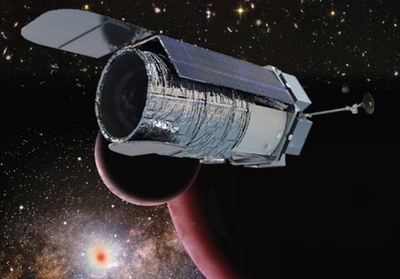Exoplanet capabilities of WFIRST-2.4by Philip Horzempa
|
| The new WFIRST will be a powerful tool in the search for and study of exoplanets in a number of ways. |
This comes during a time of confusion and angst in the agency concerning plans for astronomy missions after the James Webb Space Telescope (JWST). The Astro 2010 Decadal Survey team had pointed to two top priorities after JWST, namely WFIRST and technology development for an exoplanet direct imaging mission. NASA had made halting progress in fulfilling these objectives in the two years since the Astro 2010 report was issued. NASA had developed a plan for WFIRST, but the scenario of when and how to initiate the mission was a bit murk in the aftermath of JWST’s budget woes. In addition, the exoplanet community has taken a beating in recent years, stunned by the cancellation of the Space Interferometry Mission) and the indefinite suspension of the Terrestrial Planet Finder (TPM). How to proceed was the subject of much debate.
In the year since NASA publicly revealed its NRO gifts, things have begun to fall into place. The agency appointed a Science Definition Team (SDT) to evaluate how WFIRST could utilize one of the 2.4-meter NRO mirrors. Now, the SDT has returned with encouraging news. The team’s final report proposes an amazingly capable design for WFIRST. As a bonus, this new WFIRST will be a bonanza for exoplanet studies. It would incorporate a coronagraph that will produce groundbreaking exoplanet science. In one fell swoop, the way forward for the top two priorities of the Astro 2010 team now seems clear.
The primary mission of WFIRST is the study of distant supernova and galaxies. These targets will be used to determine the effect of dark energy on the structure and fate of the Universe. Earlier WFIRST designs had envisioned 1.2-meter optics. The use of the NRO 2.4-meter mirrors means that WFIRST can produce wide-angle, high-resolution views that will be amazing. They will be comparable to HST’s “deep field” views, but cover an area of the sky 100 times greater. There are a number of other astrophysics fields that will benefit immensely from this capability.
The new WFIRST will be a powerful tool in the search for and study of exoplanets in a number of ways. The first is through microlensing, which takes advantage of the bending of space by massive objects, as first posited by Einstein. An exoplanet that passes in front of a distant background star (not its parent star) will cause the star’s light to be slightly magnified because of this space warp. This microlensing search was part of the original WFIRST mission. However, the use of WFIRST’s large 2.4-meter diameter mirror will allow the collection of three times as much light as its original design. This translates into a richer harvest of exoplanets and an increased ability to detect small terrestrial worlds. Overall, the microlensing survey should be able to detect several hundred exoplanets. Together with the results from Kepler, this information will give us a better understanding of the architecture of other solar systems.
The Kepler transit-detecting mission, together with ground-based Doppler surveys, has provided insight into the frequency of planets orbiting the stars in our galaxy. These efforts have shown that there are a wide variety of planets in alien solar systems. In particular, Kepler has confirmed the ground-based discovery of an entirely new class of planet, the so-called “super-Earths.” These planets, intermediate in size between the Earth and ice giants such as Neptune, have no counterpart in our solar system. Their composition and environment are subject to much debate. The next step is to discern the nature of these planets. One way that this can be done is by direct imaging, i.e., obtaining photos and spectra of those distant points of light.
In order to obtain those images, the exoplanet community strongly endorsed the enhancement of WFIRST through the addition of a coronagraph. This device will block out a large fraction of the light of target stars. With much of the glare of parent stars suppressed, the telescope will be able to directly image any planets orbiting that star. The goal is to produce as narrow an image of the space around the star as possible. This is referred to as the Inner Working Angle (IWA). The more that the IWA can be shrunk, the more inner planets can be imaged. It is possible that the enhanced WFIRST may be able to view planets as close as 1 astronomical unit (AU) to their parent star, depending on their distance from our solar system.
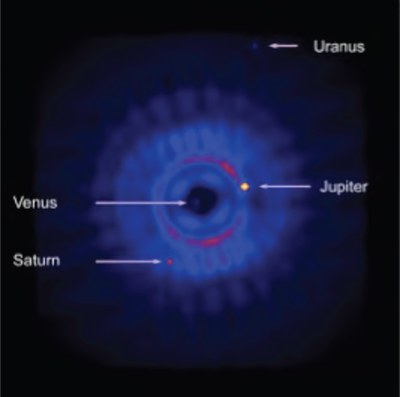 How our solar system might appear from afar, with the Sun’s light blocked by a coronagraph |
The plan is to search the closest 200 stars for planets. The telescope will not be able to image Earths, but it will be able to view Neptunes or Jupiters around our neighboring stars, if those planets are there. The results from Kepler indicate that up to 50% of all stars have some type of planet orbiting about them. Therefore, it is likely that WFIRST will be able to image tens to hundreds of alien worlds in the solar neighborhood.
| Robotic servicing is envisioned for WFIRST-2.4. This may be based on planned commercial unmanned servicing of communications satellites in GEO. |
The new WFIRST telescope will be also be able to obtain spectra of those planets, telling us something about their nature. As mentioned above, this will be the next crucial step in exoplanet exploration. We now know something about the sizes and masses of exoplanets. However, knowledge of surface composition is sorely lacking. Spectra obtained by WFIRST will help remedy this. Then, scientists will have data to help answer the questions raised by these worlds. Are they rocky planets? Gas giants? Are they ocean worlds? Are they covered in clouds? Are they worlds with compositions not found in our solar system? Some of the top targets for WFIRST will be the exoplanets discovered by the ground-based Doppler method. It will be able to confirm their existence, as well as tell us something about their personalities.
The SDT has labeled this new design WFIRST-2.4. It would be stationed in GEO, inclined 28.5 degrees. Why did the SDT choose that orbit, instead of the Earth-Sun L2 point, located about 1.5 million kilometers away? One of the main reasons concerns another aspect of the SDT design: serviceability of the telescope. The recent loss of a second control-moment gyroscope on Kepler has demonstrated the vulnerability of spacecraft that cannot be repaired or upgraded. Much like Hubble, WFIRST-2.4 will have a number of removable, replaceable modules. Robotic servicing is envisioned for this spacecraft. This may be based on planned commercial unmanned servicing of communications satellites in GEO. Serviceable space telescopes at L2 may one day be a reality, but that carries too much of technical and cost risks in the near term. That capability may lie decades in the future.
WFIRST-2.4 will have six serviceable modules. The latch design is derived from the Solar Max Multiple Mission Spacecraft. That design was proven out during Shuttle Mission STS-41C in 1984, when the Solar Max satellite was repaired by the astronaut crew. For WFIRST-2.4, a robotic service vehicle would dock to the launch vehicle payload adapter. The modules would include grapple fixtures to help make them accessible to robotic or crewed servicing spacecraft.
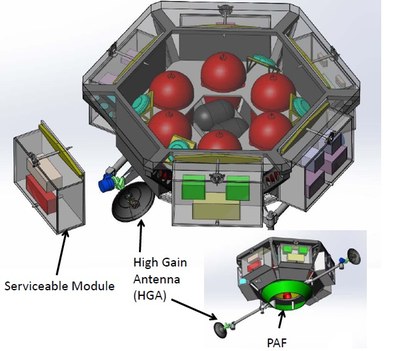 The modular design of WFIRST-2.4. |
The WFIRST-2.4 telescope will be managed by NASA Goddard and its design will be based on that center’s Solar Dynamics Observatory (SDO). This use of Goddard’s SDO experience should contribute to keeping the cost of WFIRST-2.4 low.
There are several heritage aspects of SDO that will be utilized by WFIRST-2.4. The 28.5-degree geosynchronous orbit is exactly the same as the one in which SDO is now operating. The SDO is “parked” over the White Sands area, where there are two 18-meter antennae devoted to downlinking its data. In addition, there is a 3rd antenna there that is devoted to tracking NASA’s Lunar Reconnaissance Orbiter (LRO) spacecraft. By the time that the WFIRST-2.4 launches, both the SDO and LRO missions will likely have ended. Therefore, there will be three state-of-the-art antennae sitting idle in New Mexico. There is logic in using those assets. If WFIRST-2.4 were to be placed instead at L2, there would be the added expense and complication of using the DSN.
As with SDO, WFIRST-2.4 will be in view of White Sands at all times allowing large amounts of data to be dumped to the ground every day. The wide-field images enabled by the NRO mirrors will be data-intensive. A high data rate is crucial to such WFIRST-2.4 programs as the microlensing search for exoplanets.
WFIRST-2.4 will also take advantage of hardware that has been proven on the SDO mission. This includes Ka-band transmitters on the spacecraft, as well as the main 440-newton engine that will take it to circular GEO from its transfer orbit. WFIRST-2.4 will delivered to that intermediate orbit by an Atlas V.
One drawback of placing WFIRST-2.4 in GEO is that it precludes the use of a starshade in conjunction with the telescope (See “Future exoplanet missions: NASA and the world (part 1)”, The Space Review, October 8, 2012). The advantage of a starshade is that it would more thoroughly block starlight than a coronagraph alone. That would allow the telescope to see the inner reaches of alien solar systems, locations where habitable planets may lurk. Orbital mechanics dictate that a starshade can only be used if the telescope is placed at L2. If NASA chooses to stick to the SDT’s recommendation to park the telescope in GEO, the starshade option may be used with JWST or with a next-generation telescope. However, one could imagine that after some years in geostationary orbit, the WFIRST-2.4 telescope could be towed to L2 using the solar electric propulsion (SEP) technology being developed for NASA’s asteroid retrieval mission. In fact, the starshade itself may be assembled in low Earth orbit and towed to L2 using SEP.
With the use of the NRO’s large optics, other avenues for exoplanet discovery will open up. For example, WFIRST-2.4 can study the planetary systems already discovered by Kepler and glean additional data. About 60 Kepler planets show transit timing variations (TTVs). This effect is the result of planets within one solar system gravitationally tugging on each other and can be used to calculate their masses. WFIRST’s large mirror means that it can detect TTVs that are several times smaller than Kepler, thereby allowing a finer estimate of mass. Exoplanets discovered by the just-approved Transiting Exoplanet Survey Satellite (TESS) mission could also be followed up.
In addition, WFIRST-2.4 can monitor Kepler stars that show at least one transiting planet in order to detect the frequency of smaller planets. The NRO-based telescope could detect a Mars or a Ganymede in transit. In fact, WFIRST-2.4 could detect a habitable rocky moon transiting an alien version of Jupiter.
 Illustration of a terrestrial exomoon. |
It is also possible for WFIRST-2.4 to recover much of the science that was lost when the SIM astrometry mission was canceled (See “SIM and the ‘ready, aim, aim’ syndrome”, The Space Review, October 18, 2010). This could be accomplished by an ingenious method of adding a grid of micro-dots to the primary mirror. As with the other mechanical obstructions in the optical path, these dots would not interfer with images formed by the telescope. However, those dots would produce diffraction spikes that would serve as a tool for astrometry: measuring, with exquisite detail, the positions and motions of stars. What it translates to in practice is a powerful exoplanet discovery method for WFIRST-2.4. The astrometric dots would allow the telescope to measure the masses of exoplanets, even those that do not exhibit TTVs. This astrometry capability would be a powerful tool for exoplanet discovery. It could confirm the existence of the recently announced planet circling Alpha Centauri B. It would even enable WFIRST-2.4 to sense non-transiting giant planets circling the distant Kepler stars. The SDT report does not refer specifically to this added capability, but this may be an option for WFIRST-2.4 when the final design is chosen.
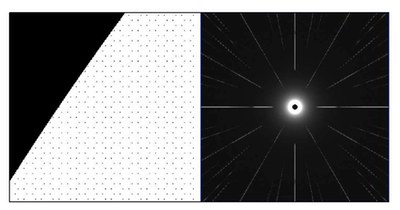 An array of micro-dots and the diffraction spikes they create. |
WFIRST-2.4 would be a formidable exoplanet mission indeed. The option of adding a coronagraph to the NRO telescope is supported by a groundswell of work conducted in NASA’s exoplanet program. The gift of these Hubble-class mirrors was fortuitous, but transforming one of them into a discovery machine is possible because of years of work on designing coronagraphs.
| In many ways, we do not know what WFIRST-2.4’s coronagraph will reveal. That is perhaps the main reason to fly this device. |
One of the pathfinding activities of WFIRST-2.4 for future exoplanet exploration is the detection of exo-zodiacal light in other solar systems. This “fog” is created by light reflected from dust in orbit about a star, and is a detriment to the direct imaging of exoplanets. Little is known about the severity of this interference in alien planetary systems. WFIRST-2.4 will be able to gauge the abundance of “exo-zod” dust in numerous star systems. This knowledge will be invaluable in future exploration. In systems where the exo-zod interference is intense, WFIRST-2.4 could still detect exoplanets if it is equipped with the array of astrometric micro-dots referred to above. Since astrometry measures the position of a planet’s parent star, it is not strongly affected by exo-zod light, like a searchlight in a fog bank. If dense exo-zod dust clouds turn out to be common, the astrometric-dot approach will save the day in the search for nearby planets. We will not know about the prevalence and density of exo-zodical dust in other solar systems until this mission is flown.
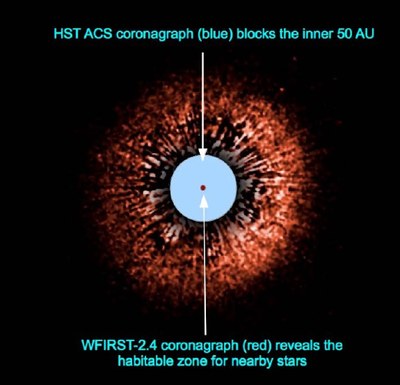 A debris disk around a neighboring star. |
The coronagraph on WFIRST-2.4 can be considered to be an exploratory instrument. It will allow the exoplanet community to get their feet wet in the use of such equipment. In many ways, we do not know what WFIRST-2.4’s coronagraph will reveal. That is perhaps the main reason to fly this device. This spacecraft will set the stage for a future imager of Earth twins. It is a crucial step on the path forward.
NASA is set to decide in June whether to proceed with further study of WFIRST-2.4. If so, then there will be a meeting of the SDT in September where progress on refining the telescope’s design will be discussed, the next step towards flying what could become a exoplanet search machine.
